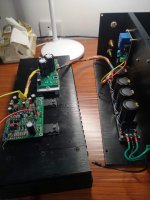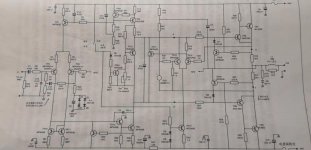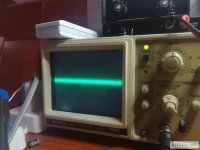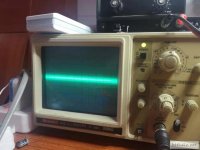22x power amplifier, the input end is open circuit, listen carefully with your ears close to the tweeter, can not hear a little noise, Close to the woofer and no noise,how about the noise parameters? ?Is it easy to do? ?
Opening the road should be harderAmplifier noise should be measured/heard with the inputs shorted.
Opening the road should be harder
You will pick up lots of ambient EM noise that is location and time dependent, unless the inputs are shorted.
22x power amplifier, the input end is open circuit, listen carefully with your ears close to the tweeter, can not hear a little noise, Close to the woofer and no noise,how about the noise parameters? ?Is it easy to do? ?
If the input is open and if you are getting very little noise it is a very good amp noise wise.
If the volume control is down to zero might explain it ?
The input terminal is open and the volume potentiometer is not connected. I'm also confused about this. What is this level?If the input is open and if you are getting very little noise it is a very good amp noise wise.
If the volume control is down to zero might explain it ?
Before installing the case, I achieved this effect through a separate power amplifier circuit board test, so no volume potentiometer was connected, and I also tried listening with headphones.
Last edited:
Do you mean ESI Planet 22x amplifier or is this A local DIY design or copy? How about a picture of your assembly and perhaps a schematic diagram to see how it is connected and if there may be problems.
See post #2 again. You cannot and do not use or measure amplifier noise when the input is open circuit. Either short the input direct to input ground or with a resistor of 1-47k which should approximate the load of a preamplifier or other high impedance source that is normally connected.
Also, perhaps you mean audio rather than noise - they have different and specific meanings when applied to electronics.
See post #2 again. You cannot and do not use or measure amplifier noise when the input is open circuit. Either short the input direct to input ground or with a resistor of 1-47k which should approximate the load of a preamplifier or other high impedance source that is normally connected.
Also, perhaps you mean audio rather than noise - they have different and specific meanings when applied to electronics.
Do you mean ESI Planet 22x amplifier or is this A local DIY design or copy? How about a picture of your assembly and perhaps a schematic diagram to see how it is connected and if there may be problems.
See post #2 again. You cannot and do not use or measure amplifier noise when the input is open circuit. Either short the input direct to input ground or with a resistor of 1-47k which should approximate the load of a preamplifier or other high impedance source that is normally connected.
Also, perhaps you mean audio rather than noise - they have different and specific meanings when applied to electronics.
noise!!
The left and right channels have the same parameters. I added a voltage regulator circuit. I cancelled the high current protection in the circuit.
Attachments
As rayma has mentioned, residual noise, particularly external noise, and wide open inputs, will produce hiss, hum, static, etc., from the speaker.
If inputs are shorted, using shorting plugs or jumpers, this tames down and eliminates such "noise", and is how amplifiers are tested.
And listening with the ear right against a speaker is not a normal way of determining such things.
Signal-to-noise ratio is derived in more professional ways of testing amps, and measured in decibels.
If inputs are shorted, using shorting plugs or jumpers, this tames down and eliminates such "noise", and is how amplifiers are tested.
And listening with the ear right against a speaker is not a normal way of determining such things.
Signal-to-noise ratio is derived in more professional ways of testing amps, and measured in decibels.
As rayma has mentioned, residual noise, particularly external noise, and wide open inputs, will produce hiss, hum, static, etc., from the speaker.
If inputs are shorted, using shorting plugs or jumpers, this tames down and eliminates such "noise", and is how amplifiers are tested.
And listening with the ear right against a speaker is not a normal way of determining such things.
Signal-to-noise ratio is derived in more professional ways of testing amps, and measured in decibels.
Residual noise, especially external noise and open inputs can cause hissing, buzzing, static electricity, etc., but this did not happen on my circuit. At low volumes, the signal-to-noise ratio usually decreases. Only by reducing the original noise can the signal-to-noise ratio be increased at low volumes.
This noise is very important if we need to listen to music at low volume during sleep. I wish there was no noise at all.
That means little to nothing.22x power amplifier, the input end is open circuit, listen carefully with your ears close to the tweeter, can not hear a little noise, Close to the woofer and no noise
Ear sensitivity can vary from deaf as a brick to "I can hear the stars singing"
Speaker sensitivity can vary fom 80 to 110 dB@1m
WHICH noise parameters? You quote no measurements.how about the noise parameters?
First define what are we talking about.?Is it easy to do? ?
That means little to nothing.
Ear sensitivity can vary from deaf as a brick to "I can hear the stars singing"
Speaker sensitivity can vary fom 80 to 110 dB@1m
WHICH noise parameters? You quote no measurements.
First define what are we talking about.
I know you want to check the signal-to-noise ratio, but I can't get the AP test. Can I use RMAA and sound cards for testing?
to reduce noise, it may help to raise R6/7 values.
likewise the input filter may help by setting the -3dB point in the 100KHz range.
likewise the input filter may help by setting the -3dB point in the 100KHz range.
The limit of human hearing is a SPL of 0dB by definition, typical speakers are say 90dB at 1 metre with 1 watt. Ear close to the speaker might be 0.05m distance, so 1 watt would be 90+26dB = 116dB (don't try this with 1 watt!!!),22x power amplifier, the input end is open circuit, listen carefully with your ears close to the tweeter, can not hear a little noise, Close to the woofer and no noise,how about the noise parameters? ?Is it easy to do? ?
so limit of hearing is -116dBW, which for 8 ohm speakers is -107dbV.
With an amp gain of 22 (= 27dB), this means the amp input noise that would be only just perceptible with your ear 5cm from the speaker is -107 - 27 = -134dBV,
or 0.2µVrms, or in terms of voltage noise density that's 1.4nV/√Hz referred to the amp input.
A good amp might be able to get that low, but its unlikely. Also with an open-circuit input (assuming 47k load resistor) will have a Johnson noise from the resistor of 28nV/√Hz, or 3.9µVrms, leading to 86µVrms at the speaker, which is -90dBW.
Thus 1 metre from the speaker the SPL level is 0dB, and 5cm from the speaker its 26dB (clearly audible). All assuming the amp isn't adding even more noise.
In short its rare to find an amp that doesn't have audible hiss with your ear up against the speaker, and open circuit inputs with standard 47k input impedance will always have objectionable levels of hiss for a quiet environment, but then again you'd never do that as the preamp will be plugged in!
The time I do hear this is with modern small music players and phones which power-down their DACs after playing, leading to a sudden noise/hiss/hum event after what was a noise-free playback.
My actual input impedance is 2.2K instead of 47K. Maybe this is the reason for reducing the noise, please see the circuit diagram provided earlierThe limit of human hearing is a SPL of 0dB by definition, typical speakers are say 90dB at 1 metre with 1 watt. Ear close to the speaker might be 0.05m distance, so 1 watt would be 90+26dB = 116dB (don't try this with 1 watt!!!),
so limit of hearing is -116dBW, which for 8 ohm speakers is -107dbV.
With an amp gain of 22 (= 27dB), this means the amp input noise that would be only just perceptible with your ear 5cm from the speaker is -107 - 27 = -134dBV,
or 0.2µVrms, or in terms of voltage noise density that's 1.4nV/√Hz referred to the amp input.
A good amp might be able to get that low, but its unlikely. Also with an open-circuit input (assuming 47k load resistor) will have a Johnson noise from the resistor of 28nV/√Hz, or 3.9µVrms, leading to 86µVrms at the speaker, which is -90dBW.
Thus 1 metre from the speaker the SPL level is 0dB, and 5cm from the speaker its 26dB (clearly audible). All assuming the amp isn't adding even more noise.
In short its rare to find an amp that doesn't have audible hiss with your ear up against the speaker, and open circuit inputs with standard 47k input impedance will always have objectionable levels of hiss for a quiet environment, but then again you'd never do that as the preamp will be plugged in!
The time I do hear this is with modern small music players and phones which power-down their DACs after playing, leading to a sudden noise/hiss/hum event after what was a noise-free playback.
The language barrier has hit this thread pretty hard. OP, be aware that people's interpretations of what you are saying seem to vary. Did you imply that
a) the circuit is dead quiet
or
b) the circuit is not dead quiet and exhibits audible noise?
If so, what is speaker sensitivity like?
My 2 cents:
1. An amplifier like the circuit shown should easily provide inaudible or near-inaudible noise by itself when used with normal-sensitivity passive speakers (85-90 dB SPL / W / m). Even assuming a mediocre 15 nV/√(Hz) input noise density, a gain of ~26 dB results in less than 50 µV of output noise. That's <-86 dBV, or >95 dB below 1 W / 8 ohm level. (You can employ an opamp output noise calculator for this exercise.)
2. Good call to whoever brought up R6/7, which should be more like 220 ohms. In any case, I'd be awfully surprised if input noise density on this one turned out to be much worse than 5-10 nV/√(Hz). Even horn speakers beyond the 100 dB / W / m mark should be quiet happy with this one.
3. Your big problem usually is not the power amp, but the preamp or whatever source you've got hanging at its input. A standard preamp is considered good when it reaches 3.5-4 µV of output noise - around twice the input noise of even a mediocre power amplifier! Likewise, getting down to 2 µV on a DAC output implies a dynamic range of 120 dB if 0dBFS = 2 Vrms. Feasible? Yes. Easy, common and cheap? Not so much. If you want 0.8 µV, it gets even harder with dynamic range requirements being pushed to 128 dB.
4. Issues like in 3) can usually be tackled with some passive attenuation ahead of the power amplifier, as preceding devices tend to provide (a) more level than required for amplifier clipping and (b) even the clipping point may generate substantially higher sound levels than required (few people are likely to require more than about 110 dB SPL, which with sensitive horn speakers could mean less than 10 watts!).
a) the circuit is dead quiet
or
b) the circuit is not dead quiet and exhibits audible noise?
If so, what is speaker sensitivity like?
My 2 cents:
1. An amplifier like the circuit shown should easily provide inaudible or near-inaudible noise by itself when used with normal-sensitivity passive speakers (85-90 dB SPL / W / m). Even assuming a mediocre 15 nV/√(Hz) input noise density, a gain of ~26 dB results in less than 50 µV of output noise. That's <-86 dBV, or >95 dB below 1 W / 8 ohm level. (You can employ an opamp output noise calculator for this exercise.)
2. Good call to whoever brought up R6/7, which should be more like 220 ohms. In any case, I'd be awfully surprised if input noise density on this one turned out to be much worse than 5-10 nV/√(Hz). Even horn speakers beyond the 100 dB / W / m mark should be quiet happy with this one.
3. Your big problem usually is not the power amp, but the preamp or whatever source you've got hanging at its input. A standard preamp is considered good when it reaches 3.5-4 µV of output noise - around twice the input noise of even a mediocre power amplifier! Likewise, getting down to 2 µV on a DAC output implies a dynamic range of 120 dB if 0dBFS = 2 Vrms. Feasible? Yes. Easy, common and cheap? Not so much. If you want 0.8 µV, it gets even harder with dynamic range requirements being pushed to 128 dB.
4. Issues like in 3) can usually be tackled with some passive attenuation ahead of the power amplifier, as preceding devices tend to provide (a) more level than required for amplifier clipping and (b) even the clipping point may generate substantially higher sound levels than required (few people are likely to require more than about 110 dB SPL, which with sensitive horn speakers could mean less than 10 watts!).
The load resistance is 8 ohms and the oscilloscope is 5MV / DIV. Power amplifiers measure at power up and power down, and they have the same amplitude. If you use this parameter, can you say that the noise during startup and shutdown is the same? Same no noise.
Attachments
Last edited:
Measuring noise with an oscilloscope seems unreliable. Is it reliable to measure with a millivolt meter?
Help look at this formula:LP = S + 10Log W -20Log D, S is the sensitivity of the speaker, W is the power, D is the distance from the speaker to the human ear, is this sound pressure calculation formula correct?
Help look at this formula:LP = S + 10Log W -20Log D, S is the sensitivity of the speaker, W is the power, D is the distance from the speaker to the human ear, is this sound pressure calculation formula correct?
Last edited:
- Home
- Amplifiers
- Solid State
- 22x power amplifier noise



